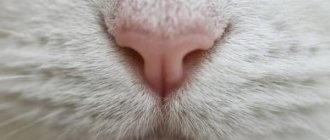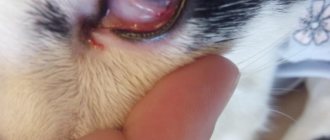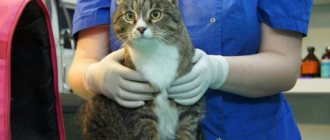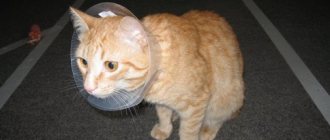Every day, more than one thousand operations to castrate domestic cats are performed in all veterinary clinics. The significance of the procedure is difficult to overestimate, since with its help it is possible to curb the increase in the number of stray animals. The operation itself is quite simple and is often performed at home. But the simplicity of the procedure does not exclude a certain probability of complications. It happens, for example, that a cat bleeds after surgery. What does this mean and should I seek help from a veterinarian?
General information
Let's make a small digression right away. Keep in mind that after a normally performed castration nothing should bleed!!!
In a healthy cat that does not have any pathologies of the blood coagulation system, the primary healing of the postoperative wound begins immediately. Moreover, the scope of surgical intervention during castration is extremely small. In fact, only the skin of the scrotal sac (scrotum) is cut, where there are simply no large blood vessels. The capillaries in this area are instantly blocked by blood clots. Even during the operation itself, very little blood is released. Please note that during the first hour and a half after the procedure, a small amount of bloody fluid (ichor) is allowed to be released, but not pure blood!
But! In cases where your cat is cryptorchid , infertility was carried out through abdominal surgery (the testes in such situations are located in the abdominal cavity), everything is somewhat different.
When a stitch bleeds after castration, there is nothing “supernatural” about this phenomenon. The release of a small amount of it does not threaten the animal with anything serious. This is only true in situations where the bleeding is really minor and continues for a maximum of three days from the moment of surgery.
In addition, it should not be accompanied by redness and swelling of the surgical area, as well as an increase in local body temperature. All these signs indicate the development of an inflammatory process, potentially dangerous to the life and health of the cat.
So the situation when a cat’s wound bleeds after deprivation does not bode well for your pet.
In any case, you will need to contact your veterinarian immediately. The sooner you do this, the better. Otherwise, he may well die from internal bleeding.
Causes of bleeding
The surgical incision for castration is small and usually does not require a suture. The wound heals on its own. A slight inflammation of the cut tissues and the release of ichor is a natural healing process that lasts two to three days. It may be accompanied by an increase in temperature up to 39.5 degrees , which does not pose a threat to the health of the animal.
The appearance of blood is an early post-castration complication. Bleeding can be arterial or venous:
- from the scrotum;
- spermatic cord.
When the venous vessels of the scrotum bleed, the blood is visible in the form of dark drops, if from the spermatic cord - droplets or a thin stream.
If a cat bleeds after castration immediately after surgery, a few hours later, or the next day, this means the following:
- poor blood clotting;
- poorly performed surgery;
- poor home care.
© shutterstock
The problem with clotting is solved with the help of a prophylactic injection of ethamsylate. The drug has a short activation period (4 hours), which will stop the leakage.
But, if the wound bleeds after castration for longer than 5 days, then you need to tell the doctor about it.
Bleeding can be not only external, but also internal. It is diagnosed by increasing signs of anemia: general weakness of the animal, lack of appetite, pallor of the tongue and the inner surface of the ears. This may indicate infection of the wound either in the hospital or at home, and requires the use of antibacterial drugs and restoratives (vitamins).
Poor ligature application
You need to understand what exactly happens during the operation.
- The veterinarian cuts the skin of the scrotum.
- Cuts the testicular ligament.
- Places a clamp and ligature on the cord formed by the vas deferens and blood vessels.
The latter enter the abdominal cavity through an opening called the inguinal ring. The life of the animal depends on the quality of the ligature over which the testis is cut off. If the suture material was placed carelessly, or the thread used for the dressing was of poor quality, the knot will almost inevitably become loose. The worst thing is that the stump of the cord after the operation goes into the abdominal cavity...
What will happen as a result? Nothing good - massive bleeding will develop , as a result of which the entire abdominal cavity can turn into a container for blood. The only way to save the cat is immediate abdominal surgery. During this process, it is necessary to urgently find the “escaped” vessels and re-bandage them. There are cases where animals died within half an hour, when the owners had just managed to pick them up from the veterinarian.
Not in all cases, a poor-quality ligature is to blame. Practitioners believe that approximately 0.5-1.5% of all cats have pathologies of the blood coagulation system (for example, thrombocytopenia of various etiologies). If they are not identified in time and surgery is performed, the cat may die from massive hemorrhage, even if the castration itself was performed perfectly.
Please note! Poor blood clotting cannot be detected by eye. It is in order to identify such pathologies that it is necessary to conduct a full medical examination of the animal at the stage of preparation for castration.
Damage to the penis
The genital organs (i.e. penis and scrotum) are anatomically very close to each other. Therefore, if castration is performed carelessly (as well as in cases where the cat is poorly fixed and “jerks” a lot), the possibility of damage to the urethral canal cannot be ruled out. Such cases are very rare, but they still happen. And the cat in such a situation faces not only the need for additional surgery, but also a very long recovery period.
Any damage to the penis, which consists of large cavernous bodies, always leads to intense bleeding. It is often so intense that the animal dies from severe blood loss within a few minutes.
Moreover, even with successful relief of hemorrhage, it happens that the tissues of the penis, which are very demanding of nutrition and oxygen, partially die, and processes of necrotic decay develop in them. To prevent an animal from becoming a “eunuch” in the full sense of the word, a complex and very expensive operation for plastic surgery of the penis is required. And, by the way, not every veterinary surgeon will undertake to perform it.
Foreign veterinary periodicals describe cases where, as a result of damage to the penis, veterinarians had to “feminize” a cat, making his penis something like a female vulva. This is easier than forming a new sexual organ.
Damage to the urethral canal
In even rarer cases, castration may be complicated by damage to the urethra. In the urethra itself, of course, there are not many large blood vessels, but the available quantity is enough for the development of clearly visible bleeding. In particular, blood will constantly appear in the urine of such a pet.
In severe cases, urine will look like tomato juice . The most severe situations are characterized by gradual leakage of urine from the damaged urethra into the surrounding tissues of the penis. Since urine is a liquid that is very caustic from a chemical point of view, everything ends in severe necrosis of the penis. This often leads to the need for surgical amputation, as a result of which the cat becomes disabled.
The most unpleasant thing is that the owners sometimes don’t notice anything for a long time . In such cases, blood is released briefly and in small volumes. It, being mixed with urine, accumulates in the cavernous bodies of the penis and begins to rot there. Within about two days, the penis swells greatly, turns red, and becomes very painful. As in the previous case, this pathology requires immediate hospitalization of the cat and additional surgery. There is nothing you can do about this at home.
Conclusion. What should you do if a recently operated cat is bleeding from somewhere in the genital area? Contact a veterinarian immediately! This is the only way you can protect the health and life of your pet.
Postoperative care for a cat/cat, after sterilization, castration
When you take your cat to the clinic for sterilization, place a towel or rag on the bottom of the carrier; the warmer the better. After surgery, the animal's body temperature may drop slightly, so the cat will need to be wrapped in something warm.
1.Immediately after the operation, the cat must be put on a post-operative blanket, which will prevent the stitches from becoming infected and licking. The blanket is removed only while the seams are being processed, then put on again. The blanket must be worn, even if the cat does not show interest in the seams, and you do not see how she licks them. After the stitches are removed (usually 7-12 days after surgery), the blanket is worn for another 2-3 days. If you are given a cat that is still under anesthesia, you need to continuously monitor it until it begins to move independently and consciously.
2. Having brought the operated animal home, for the first 24 hours you will have to watch how it recovers from anesthesia. Lay something warm on the floor and place the cat on the bedding. Please note that there should be no drafts in the room. Do not place your pet on a surface (for example, on a chair or sofa): when coming out of anesthesia, the animal may suddenly jump up on its paws and run and will certainly fall to the floor from a height. During and after anesthesia, the animals' body temperature drops, so after anesthesia, the cat must be placed on the floor on a warm bedding (in no case on a sofa or other heights to avoid falling and injury), covered with something on top, and, if necessary, placed a heating pad under your back.
3. The movements of a cat recovering from anesthesia are not coordinated. She can get up, walk a few steps and fall again, she can bury herself in a corner and move her paws helplessly. The animal is not yet adequate. Just carefully pick it up and place it back on the mat. Remove hot and sharp objects from the floor; note that there should be no threads or wires on the floor in which the cat could become entangled. Remember: she is still practically asleep and completely helpless. It is advisable for the cat to lie on its right side after sterilization (in no case on the left, so that there is no additional stress on the heart after the operation). When waking up after anesthesia, cats usually alternate between states of deep sleep and increased motor activity; she may jump up and run or crawl until she hits some obstacle or falls on her side, she is disoriented, and may suddenly begin to meow loudly or try to roll over. This condition can persist after surgery from 2 to 8-12 hours. The cat may be lethargic and sleepy for up to 48 hours after surgery.
4. Cats do not close their eyes during anesthesia. Their eyes are open even during surgery. To avoid drying out the mucous membrane of the eyes, a special solution is instilled. But you will still have to close and open your cat's eyelids with your fingers every 20-30 minutes until she starts blinking on her own or until she closes her eyes. The cat's mouth will become dry, so it is advisable to moisten it with water or carefully feed the cat with a pipette, making sure that it swallows the liquid and does not choke. You need very little water, give it drop by drop. Turn it from side to side every hour or two. If the cat wants to go to the toilet, you need to help her by supporting her with a towel under her stomach for better stability and stimulation of defecation and urination.
5. After sterilization, a cat may frighten you with its behavior. Remember: if a cat is sleeping, and then suddenly wakes up and starts running, and then just as suddenly falls; if she tries to crawl somewhere or scratches her paws on the floor, if she meows or hisses and then falls silent; If you bump into corners and walls when walking, this is normal. The animal is disoriented, that's all. However, if you think that something is wrong with your pet’s recovery from anesthesia, call the veterinarian who performed the operation.
6. A cat may experience involuntary urination on the first day after surgery. Make sure your animal moves on surfaces that can be easily cleaned. In addition, a cat may vomit after anesthesia. Keep a bag or pot ready. Usually, before vomiting, the cat begins to lick itself involuntarily and without stopping. Pay attention to this.
7. It is recommended to feed the cat only 24 hours after sterilization (and operations in general), and to give it water after 3-4 hours. For another two or three days after anesthesia, the cat may have poor appetite. Typically, the cat can eat within a few hours after surgery. If food refusal occurs for more than a day, this is a reason to contact your doctor. If your cat ate dry food before the operation, then after recovery from anesthesia you can offer her a special canned postoperative food (from Royal Canin, Eukanuba, Hill's).
8. During anesthesia, intestinal motility slows down and, as a result, the movement of feces through the intestines. If the cat has no stool for more than 3-4 days after surgery, you can give the cat the laxative Forlax or Duphalac, after consulting with your doctor. 9. When treating sutures and antibiotic therapy, follow the recommendations of your doctor.
10. Caring for a neutered cat ends here. In about a day he will feel much better, and after 3-4 days he will calmly move around the apartment. He won't need any stitches.
Note: You should constantly monitor your temperature, whether the bandage is wet with blood, the color of your gums, and your regularity of urination.
11. Caring for a sterilized cat is much more difficult. The seams will need to be treated regularly (to do this, the blanket is removed from the hind legs and put back on after treatment). There is one danger associated with this blanket: after 5-6 days the cat may think that it is already healthy, and the tailed one will again begin to try to jump onto the bedside table, windowsill, sofa, etc. It is likely that the cat will not be able to jump. It happens that the blanket gets caught on something (for example, the handles on the door of a bedside table) and the cat hangs on it. Firstly, it will not be easy to remove the cat: it will meow loudly, squirm, hiss, bite and scratch. Secondly, if this happens when no one is home, the consequences can be dire. Before removing the stitches, limit the cat's movement in the house, try to protect it from the danger described above. Postoperative complications. 1. Post-anesthesia hypothermia. If after the operation the cat lies motionless for a long time, its paws and ears are cold, measure its temperature (with a thermometer in the anus), if the temperature is below 37 C and does not rise after covering the cat with warm heating pads, consult a doctor immediately!
2. Internal bleeding. You may suspect bleeding if your cat oozes blood from a skin suture, is lethargic for a long time, has a painful abdomen, and has pale, almost white, mucous membranes. If these signs occur, consult a doctor immediately!
3. Postoperative rise in temperature can normally last up to 3 days after surgery; if the temperature is above 39C for a longer period of time, consultation and examination by a doctor is necessary!
4. Postoperative swelling and redness around the suture can last up to 5 days after surgery, after which it slowly begins to subside and should not be there before the sutures are removed. Long-term consequences of sterilization (castration).
1. Obesity. After the cat recovers from surgery, it must be switched to a special ready-made low-calorie diet for neutered cats or to a strict diet, because... castrated animals are predisposed to obesity.
2. Syndrome of preserved ovarian tissue. With incomplete resection (removal) of ovarian tissue, behavioral manifestations of estrus (estrus) may be observed. These cats are evaluated using hormonal tests and vaginal cytology, and if the presence of ovarian tissue in the body is confirmed, then repeat surgery is recommended for these animals.
based on materials from the site https://kisorg.by/forum/topic_345











